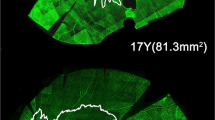Abstract
A method is presented that demonstrates the whole network of the blood capillaries of the human retina, making it possible (using a dark-field microscope at high magnification) to view the three-dimensional arrangement of this network in different planes by moving the drive of the microscope. The basic principle includes filling the vascular system with oxygen in statu nascendi by injection of H2O2 into the vitreous body of the intact eye and achieving fixation of the retinal tissue by application of a mixture of H2O2 and ethanol, and rendering the dry and flat retinal preparation transparent by soaking it in a specially prepared resin. The retinal vessels are made visible in an optically empty dark field by diffraction of light in a gas-filled specimen. This method allows preparation of the human retinal vasculature in simply enucleated eyes without cannulation of the central retinal artery and, therefore, it may be appropriate to support pathological and anatomical investigations.
Similar content being viewed by others
References
Ashton N (1950) Injection of retinal vascular system in diabetic retinopathy. Br J Ophthalmol 34:38–41
Benninghoff A (1950) Lehrbuch der Anatomie des Menschen, vol III, 3rd edn. Urban und Schwarzenberg, München Berlin, p 360
Henkind P (1967) New observations on the radial peripapillary capillaries. Invest Ophthalmol 6:30–108
Henkind P (1967) Radial peripapillary capillaries of the retina. I. Anatomy: human and comparative. Br J Ophthalmol 51:115–123
Hogan MJ, Feeney L (1963) The ultrastructure of the retinal blood vessels. 1. The larger vessels. J Ultrastruct Res 9:10–28
Hogan MJ, Feeney L (1963) The ultrastructure of the retinal blood vessels. 2. The small vessels. J Ultrastructure Res 9:29–46
Krauss R (1935) Zur Methode der Luftfüllung, Herstellung von Dauerpräparation luftgefüllter Gefäße in dünnen Häuten. Z Wiss Mikrosk Mikrosk Tech 52:312
Kuwabara T, Cogan DG (1960) Studies of retinal vascular patterns. Normal architecture. AMA Arch Ophthalmol 64:904–911
Michaelson IC (1954) Retinal circulation in man and animals. Thomas, Springfield, Ill
Risco JM, Nopanitaya W (1980) Ocular microcirculation. Invest Ophthalmol Vis Sci 19:5–12
Risco JM, Grimson BS, Johnson PT (1981) Arch Ophthalmol 99:864
Shimizu K, Ujiie K (1978) Structure of vascular vessels. Igaku-Shoin, Tokyo New York
Toussaint DT, Kuwabara T, Cogan DG (1961) Studies of retinal vascular patterns. 2. Human retinal vessels, studies in three dimensions. Arch Ophthalmol 65:575–581
Ujiie K (1976) Three-dimensional view of the retinal capillary. (in Japanise) Acta Soc Ophthalmol Jpn 80:634–644
Wybar C (1965) Anastomoses between the retinal and ciliary arterial circulations. Br J Ophthalmol 40:65–81
Author information
Authors and Affiliations
Rights and permissions
About this article
Cite this article
Krauss, R. New technique to demonstrate the network of blood capillaries of the human retina in their three-dimensional arrangement. Graefe’s Arch Clin Exp Ophthalmol 228, 187–190 (1990). https://doi.org/10.1007/BF02764316
Received:
Accepted:
Issue Date:
DOI: https://doi.org/10.1007/BF02764316




